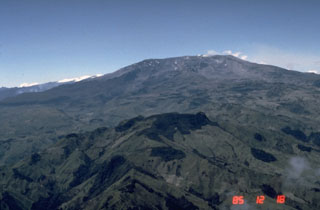Report on Nevado del Ruiz (Colombia) — 23 September-29 September 2015
Smithsonian Institution / US Geological Survey
Weekly Volcanic Activity Report, 23 September-29 September 2015
Managing Editor: Sally Sennert.
Please cite this report as:
Global Volcanism Program, 2015. Report on Nevado del Ruiz (Colombia) (Sennert, S, ed.). Weekly Volcanic Activity Report, 23 September-29 September 2015. Smithsonian Institution and US Geological Survey.
Nevado del Ruiz
Colombia
4.892°N, 75.324°W; summit elev. 5279 m
All times are local (unless otherwise noted)
Servicio Geológico Colombiano’s (SGC) Observatorio Vulcanológico y Sismológico de Manizales reported that during 22-28 September seismicity at Nevado del Ruiz was characterized by long-period earthquakes and short-duration volcanic tremor associated with gas-and-ash emissions. Earthquakes occurred at depths between 1.3 and 7.5 km. The largest event was recorded at 1027 on 22 September, a local M 1.1, near Arenas Crater at a depth of 4 km. Water-vapor, gas, and ash plumes rose 2 km above the crater and drifted mainly NW. Thermal anomalies over the crater were sometimes detected in satellite images; a significant anomaly was detected on 26 September. A pulse of tremor at 1633 on 28 September was accompanied by an ash emission that drifted E and W. The Alert Level remained at III (Yellow; "changes in the behavior of volcanic activity").
Geological Summary. Nevado del Ruiz is a broad, glacier-covered volcano in central Colombia that covers more than 200 km2. Three major edifices, composed of andesitic and dacitic lavas and andesitic pyroclastics, have been constructed since the beginning of the Pleistocene. The modern cone consists of a broad cluster of lava domes built within the caldera of an older edifice. The 1-km-wide, 240-m-deep Arenas crater occupies the summit. The prominent La Olleta pyroclastic cone located on the SW flank may also have been active in historical time. Steep headwalls of massive landslides cut the flanks. Melting of its summit icecap during historical eruptions, which date back to the 16th century, has resulted in devastating lahars, including one in 1985 that was South America's deadliest eruption.

